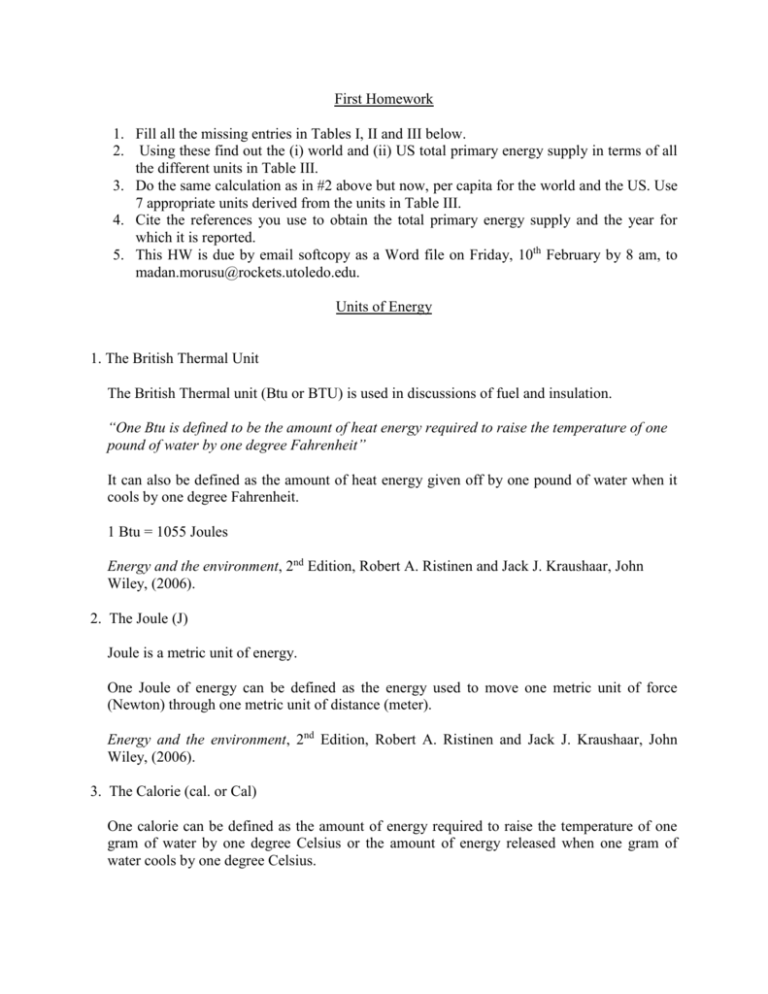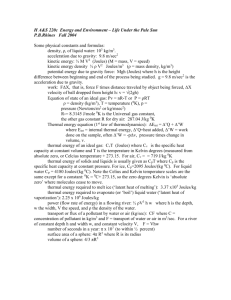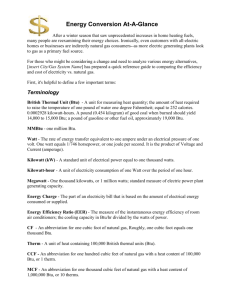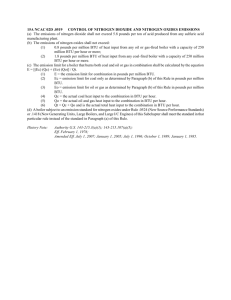1. Home work 1
advertisement

First Homework 1. Fill all the missing entries in Tables I, II and III below. 2. Using these find out the (i) world and (ii) US total primary energy supply in terms of all the different units in Table III. 3. Do the same calculation as in #2 above but now, per capita for the world and the US. Use 7 appropriate units derived from the units in Table III. 4. Cite the references you use to obtain the total primary energy supply and the year for which it is reported. 5. This HW is due by email softcopy as a Word file on Friday, 10th February by 8 am, to madan.morusu@rockets.utoledo.edu. Units of Energy 1. The British Thermal Unit The British Thermal unit (Btu or BTU) is used in discussions of fuel and insulation. “One Btu is defined to be the amount of heat energy required to raise the temperature of one pound of water by one degree Fahrenheit” It can also be defined as the amount of heat energy given off by one pound of water when it cools by one degree Fahrenheit. 1 Btu = 1055 Joules Energy and the environment, 2nd Edition, Robert A. Ristinen and Jack J. Kraushaar, John Wiley, (2006). 2. The Joule (J) Joule is a metric unit of energy. One Joule of energy can be defined as the energy used to move one metric unit of force (Newton) through one metric unit of distance (meter). Energy and the environment, 2nd Edition, Robert A. Ristinen and Jack J. Kraushaar, John Wiley, (2006). 3. The Calorie (cal. or Cal) One calorie can be defined as the amount of energy required to raise the temperature of one gram of water by one degree Celsius or the amount of energy released when one gram of water cools by one degree Celsius. It should be noted that calories are also used to discuss food energy and this is different. A food Calorie is 1000 times larger than the calorie used in physics or chemistry. Hence 1 foodcalorie = 1000 calories. Energy and the environment, 2nd Edition, Robert A. Ristinen and Jack J. Kraushaar, John Wiley, (2006). 4. Kilowatt-hour (kWh) It is a unit of energy which is equal to 1000 Watt hours or 3.6 Mega Joules. It is the multiplication of power in watts and time in hours. It is a common billing unit for energy delivered to consumers by electric utilities. 5. Barrel of Oil Equivalent (boe or BOE) It is a unit of energy based on the approximate energy released by burning one barrel (42 US gallons or 158.9873 liters) of crude oil. It is used by oil and gas companies in their financial statements as a way of combining oil and natural gas reserves and production. 6. Ton of oil equivalent (toe or TOE) It is a unit of energy released by burning one ton of crude oil, which is approximately 42 GJ. (GJ - Giga Joules) 7. Cubic ft. of natural gas o A standard of cubic foot is a measure of quantity of gas equal to a cubic foot of volume at 60 Fahrenheit at 14.73 psi of pressure. It is therefore not a unit of energy directly but of quantity. 8. Cubic meter of natural gas One cubic meter of dry natural gas is equal to 35.3147 cubic feet of natural gas by a simple geometrical conversion from meters to feet. http://www.extension.iastate.edu/agdm/wholefarm/pdf/c6-89.pdf 9. Kilowatt- year (kWyr) Kilowatt-year is the same as that of Kilowatt-hour except for the fact that it is calculated for an entire year by multiplying KWhr with the number of days (365) in the year and the number of hours (24) in a day. Conversion Tables Table I BTU BOE TOE J cal kWh kWyr Cubic ft of natural gas Cubic meter of natural gas short ton of coal metric ton of coal BTU 1 BOE 1.72 x 10-7 1 TOE J 1 4.21 x 1010 1 cal 1 Examples of how to read from Table I 1 BTU = 1.72413 x 10-7 BOE (Barrel of Oil Equivalent) 1 TOE = 4.20579 x 1010 J Table II kWh BTU BOE TOE J cal 2.78 x 10-7 kW-yr Cubic ft of natural gas Cubic meter of natural gas short ton of coal metric ton of coal kWh kWyr Cubic ft of natural gas Cubic meter of natural gas short ton of coal metric ton of coal 1 2.91 x 104 1 1 1 1 1 Examples of how to read from Table - II 1 Joule = 2.77814 x 10-7 kWh 1 kWyr = 2.910072 x 104 Cubic ft. of natural gas TW - yr TW - yr 100 Quad Btu 10 GTon Oil Eq. ExaJoules (EJ) 10 Giga Barrels of Oil 1 Giga Short Tons of Coal 1 Giga Metric Tons of Coal 100 Quad Btu Table III 10 GTon Oil ExaJoules Eq. (EJ) 1 10 Giga Barrels of Oil Eq. 1 Giga Short Tons of Coal 1 Giga Metric Tons of Coal 31.53 1 1 6.87 1 1 1 1 Examples of how to read from Table - III 1 TW - yr = 31.53188 EJ 10 GTon Oil Eq. = 6.87293 10 Giga BOE Conversion Factors 1.0846 MJ = Cubic ft of natural gas 5.8 MBTU = BOE 3.4121x 103 BTU = kWh 4.1868 J = cal 3.9683x103 BTU = cal 1.0551x103 J = BTU 7.33 BOE = TOE tonto.eia.doe.gov/kids/energy.cfm?page=about_energy_conversion _calculator-basics tonto.eia.doe.gov/energyexplained/index.cfm?page= about_energy_units Warren Lee McCabe, Julian Cleveland Smith, Peter Harriott Unit Operations of Chemical Engineering, 7th ed. (McGraw-Hill, 2005) ISBN 0072848235, 9780072848236 www.spe.org/industry/reference/unit_conversions.php * 1 Cal = 1000 cal The following values are taken from reference [6] 1 short ton (ton) (coal) = 2,000 pounds = 6.65 barrels (crude oil) eq. 1 metric ton (tonne) (coal) = 2,200 pounds 1 barrel (bbl) = 42 gallons = 5.615 cubic feet = 159.0 liters 1 therm = 105 Btu = 100,000 Btu 1 thousand Btu (MBtu) = 1,000 Btu 1 million Btu (MMBtu) = 1,000,000 Btu 1 quad = 1 quadrillion Btu = 1015 Btu = 1,000,000,000 MMBtu 1 kilowatt-hour (kWh) = 1,000 watt-hours 1 megawatt-hour (MWh) = 1,000 kWh or 1,000,000 watt-hours 1 gigawatt-hour (GWh) = 1,000 MWh or 1,000,000,000 watt-hours References [1] 1 cubic meter = 35.3144754 cubic feet http://tonto.eia.doe.gov/kids/energy.cfm?page=about_energy_conversion_calculator-basics [2] http://www.aga.org/Kc/aboutnaturalgas/additional/HowtoMeasureNaturalGas.htm [3] http://bioenergy.ornl.gov/papers/misc/energy_conv.html [4] http://www.iea.org/stats/unit.asp [5] 1 kWyr = 1 kWh * 24* 365 = 8760 kWh [6] http://www.uwsp.edu/cnr/wcee/keep/Mod1/Whatis/energyresourcetables.htm Citations for Unit Conversion Sources BTU, BOE, TOE - http://www.iea.org/stats/unit.asp Joules, kWhr, kWyr - http://www.unc.edu/~rowlett/units/dictK.html For conversion to cubic feet of natural gashttp://www.aga.org/Kc/aboutnaturalgas/additional/HowtoMeasureNaturalGas.htm







